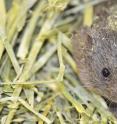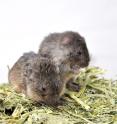Togetherness relieves stress in Prairie voles
Related images
(click to enlarge)
Many people feel anxious in crowds. But not so for prairie voles. When these mouse-like creatures live in close quarters, they are less stressed out, researchers report in the January issue of the journal General and Comparative Endocrinology.
The study is part of a larger field of research on how social stresses such as crowding and isolation affect brain chemistry and behavior in many species, including humans.
Prairie voles are small rodents ubiquitous in meadows and grasslands in the Midwest and Canada. One of the few mammals that mate for life, prairie voles have long attracted the attention of scientists trying to understand the genetics and physiology of social bonds.
Duke University postdoctoral researcher Dimitri Blondel and colleagues studied prairie voles living in fenced enclosures in a hayfield in southern Illinois.
Removable gates allowed the researchers to divide or connect the enclosures and corral the animals into smaller or larger spaces.
In one set of trials -- once in the summer and again in the fall -- two dozen voles were released in a quarter-acre sized enclosure, where they roamed for three weeks at a density of 97 animals per acre.
In another set of trials held at the same time, two dozen voles were allowed to spread out over a larger area, at a density of 32 animals per acre.
Radio collars allowed the scientists to trace each animal's whereabouts during the trials. The team also took fecal samples, which were used to measure levels of a stress hormone called corticosterone.
They found that voles in the smaller, higher-density enclosures bumped into each other nearly twice as often as those in the roomier, low-density enclosures.
But the voles corralled into tighter quarters were also less stressed out. When vole densities tripled, their stress hormone levels dropped by roughly 20 percent.
The results are surprising because most animal studies link increased crowding with higher stress. "Crowding usually forces territorial animals to compete more fiercely for limited supplies of things like food, mates and prime sleeping or nesting spots," Blondel said.
Prairie vole populations boom and bust in cycles, fluctuating from a handful of animals per acre during a crash, up to several hundred per acre during peak years.
One reason why too much elbow room raises alarm could be that at lower densities, it takes more time and energy to find a mate, Blondel said. Previous studies have shown that when stress hormone levels go up in male prairie voles, bachelor males are more likely to pair up with females they have already met.
Thinning crowds could also be a sign that snakes, hawks or other predators might be near. Boosting stress hormone production may be a way of priming the animals to fight or flee.
"If you were on a deserted street at night, you might have a higher stress level than if you were in a crowd of 20 people walking down the street," Blondel said.
Source: Duke University
Articles on the same topic
- Discovery of consoling behavior in prairie voles may benefit autism researchThu, 21 Jan 2016, 19:58:28 UTC
Other sources
- Observatory: For Prairie Voles, a Furry Shoulder to Cry Onfrom NY Times ScienceSat, 23 Jan 2016, 8:31:32 UTC
- Study: Prairie voles console loved ones who are stressedfrom UPISat, 23 Jan 2016, 3:21:12 UTC
- Study: Prarie voles console loved ones who are stressedfrom UPIFri, 22 Jan 2016, 23:50:42 UTC
- Empathy more common in animals than thoughtfrom Science DailyFri, 22 Jan 2016, 19:04:38 UTC
- [Report] Oxytocin-dependent consolation behavior in rodentsfrom Science NOWThu, 21 Jan 2016, 21:55:52 UTC
- Discovery of consoling behavior in prairie voles may benefit autism researchfrom PhysorgThu, 21 Jan 2016, 19:12:26 UTC
- Togetherness Relieves Stress in Prairie Volesfrom Science BlogWed, 20 Jan 2016, 14:01:02 UTC
- Study: Prairie voles more comfortable, less stressed in numbers than alonefrom UPITue, 19 Jan 2016, 23:20:42 UTC
- Togetherness relieves stress in Prairie volesfrom PhysorgTue, 19 Jan 2016, 20:26:14 UTC

